Tags: Airship America, Gimbel Brothers, Gimbels Department Store, Melvin Vaniman, New York History, Trent, W.G. McAdoo, Walt Wellman

Handsome
tabby Trent and Melvin Vaniman, the chief engineer of America, shortly
after being rescued by the crew of the RMS Trent in October 1910.
On October 22, 1910, a month after the new Gimbel Brothers Department Store opened at Greeley Square in New York City, Walter Wellman’s 27-foot lifeboat and the large tabby cat that was rescued from his hydrogen dirigible, America, were on exhibition on the fourth floor of the new department store.
Trent, lying atop comfy pillows in a gilded cage, attracted crowds of sightseers — especially women and children — who couldn’t wait to meet the famous cat that attempted a trans-Atlantic crossing in an airship. As a continuous line of people tried to pet and woo him, Trent ignored their attention and declined to be sociable.
I’m going out on a limb here, but maybe the poor cat was trying to ignore everyone because he had just gone through a very dramatic experience that I know for a fact would have traumatized most cats for all the rest of their nine lives.
From Atlantic City Stray to Airship Mascot
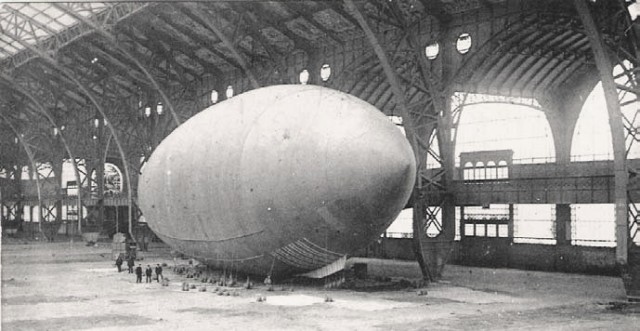 The America was a 165-long, non-rigid airship built by Mutin Godard in France in 1906 for the journalist Walter Wellman‘s attempt to reach the North Pole by air. The airship took off from Atlantic City, New Jersey, on October 15, 1910.
The America was a 165-long, non-rigid airship built by Mutin Godard in France in 1906 for the journalist Walter Wellman‘s attempt to reach the North Pole by air. The airship took off from Atlantic City, New Jersey, on October 15, 1910. Trent — then called Kiddo — was tossed into the lifeboat, which was attached just under the airship. Here, radio man Jack Irwin had his post (America was the first aircraft to carry radio equipment).

Melvin Vaniman and Trent look like the best of friends in their publicity portrait.
Chief Engineer Melvin Vaniman was reportedly so annoyed by the antics of Kiddo that he made the first-ever in-flight radio transmission to a secretary back on land. “Roy, come and get this goddamn cat!” he yelled.

Kiddo was renamed Trent following the rescue.
Eventually, Kiddo settled down and took his job as feline co-pilot quite seriously. (One of his duties was to try to keep the napping men awake by lounging on their faces.)
Navigator Murray Simon, who had told the press that one must never cross the Atlantic in an airship without a cat, wrote that Kiddo was “more useful than any barometer.”
Although the airship set several new records by staying aloft for almost 72 hours and traveling over 1000 miles, weather and other problems forced the crew to ditch the airship and join Kiddo in the lifeboat. Somewhere west of Bermuda, they sighted the Royal Mail Steamship Trent. After using Morse code to attract the ship’s attention, Jack Irwin made the first aerial distress call by radio.
As the airship drifted out of sight — never to be seen again — the crew of the RMS Trent rescued all the men and their cat Kiddo and returned them to New York. Murray Simon reminded the crew that it had been a good idea to bring Kiddo on the journey, because cats have nine lives.
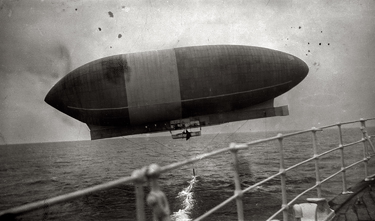
The airship America, as seen from the deck of the RMS Trent en route to New York City.
Following the airship’s rescue, Melvin Vaniman and Kiddo — now called Trent — were invited to help the Gimbel brothers celebrate the opening of their New York store on Broadway and 32nd Street. As this blog explores the history of New York City through animal stories, a pictorial look at the history of Gimbels is in store.
Although Gimbel Brothers New York officially opened on September 29, 1010, the history of this particular store at Greeley Square goes back to 1874, when the Hudson Tunnel Railroad Company initiated plans to construct a railroad that would connect New Jersey and New York City via a tunnel under the mile-wide Hudson River (today we call this the PATH train).
Construction began in 1874, but litigation and lack of funding caused numerous delays over the years. Finally in February 1902, the New York and Jersey Railroad Company took over all of the railroad company’s tunnels and lines of railway, including 4,000 feet of tunnel that had already been constructed.
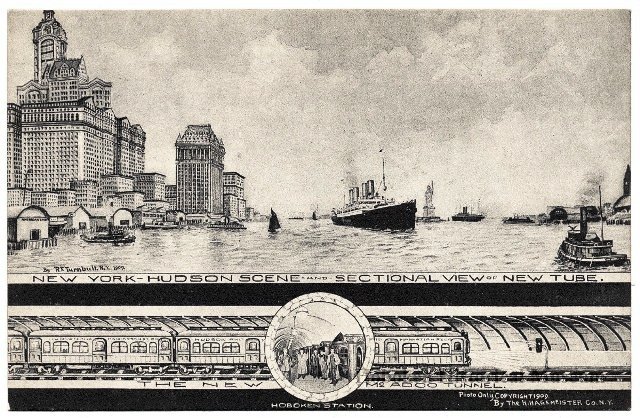
In 1904, the newly formed Hudson and Manhattan Railroad Company (H&M) filed an application to extend the McAdoo Tunnel to a larger underground terminal on Sixth Avenue at 33rd Street. The proposed site was occupied by several landmarks, including Trainor’s hotel and restaurant and the Manhattan Theatre (formerly the Standard Theatre) on Sixth Avenue, all of which were condemned and demolished in 1905.
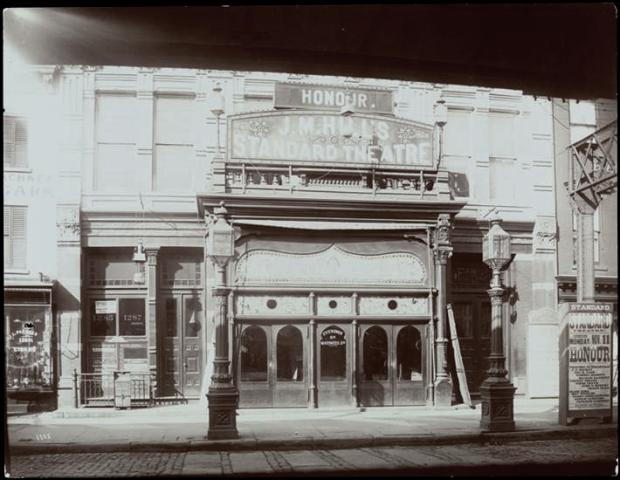
The old Standard Theatre on Sixth Avenue and 33rd Street (later called the Manhattan Theatre), was being managed by James M. Hill when
this photo was taken in 1895. The theater was one of many buildings
demolished to make way for the 33rd Street terminal and, later, the
Gimbel Brothers department store. New York Public Library digital
collections.

Greeeley
Square between Broadway and Sixth Avenue, looking southwest from about
34th Street. When this photo was taken, the Manhattan Theatre and
Trainor’s restaurant were still standing across from the Sixth Avenue
elevated train station. It was here that the Gimbel Brothers department
store would be built in 1909. NYPL digital collections.

The Broadway side of Greeley Square, as seen in 1807. NYPD digital collections.

Following
five months of excavation work, construction on the new department
store started in October 1909. NYPL digital collections
On December 8, 1909, a copper box containing a history of the Gimbels and other data was placed in the cornerstone. The $12 million building was completed ahead of schedule on June 11, 1910.

Here
is Gimbels in 1920, three years before the department store merged with
Saks (directly across 33rd Street), and five years before the Gimbels
purchased the 18-story Cuyler Building (directly across 32nd Street) .
NYPL digital collections
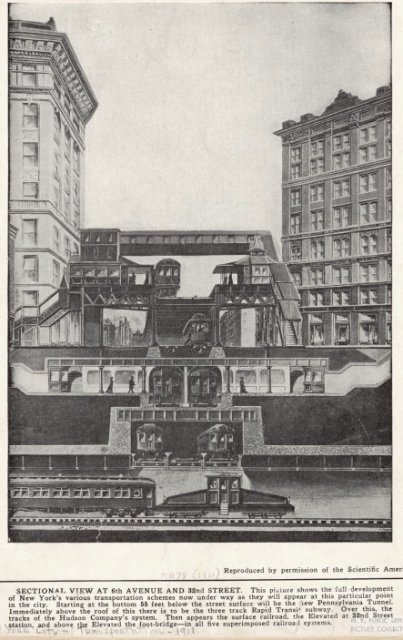
Here’s
a look under and above Greeley Square at Sixth Avenue and 32nd Street
in the early 1900s. At the bottom, 50 feet below the street, is the new
Pennsylvania Tunnel leading out of Penn Station. Above that is the Rapid
Transit subway and then the tracks of the old McAdoo system (today’s
PATH). Back then, there was also a surface railroad and an elevated
train with a foot bridge that served Gimbels shoppers.

The three-story sky bridge as it looks today. Photo by P. Gavan
As for Trent, he lived out the rest of his eight remaining lives on land with Edith Wellman, the daughter of Walter Wellman, in Washington, D.C.

The
Manhattan Mall and JCPenney now occupy the old Gimbel Brothers
building, and Greeley Square is occupied by an open-air food market
called Broadway Bites. Photo by P. Gavan

